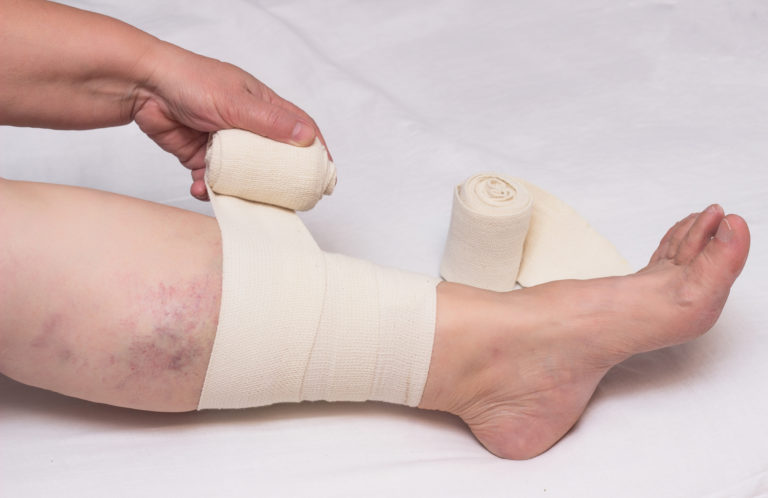Chronic Venous Insufficiency
 Chronic Venous Insufficiency (CVI) is a condition wherein the leg veins are not able to pump enough blood back to the heart. It is caused by three factors. The first is the congenital absence of or damage to venous valves. The second is venous incompetence from thrombi. The third is thrombi formation which is primarily caused by venous stasis, hypercoagulability, and endothelial trauma. These are collectively known as Virchow triad. This makes it more difficult for blood in the legs to return to the heart. Once the blood starts to pool in the leg veins, varicose veins may appear. The condition may come with various symptoms. It may even lead some individuals to feel embarrassed due to the often unsightly appearance of varicose veins.
Chronic Venous Insufficiency (CVI) is a condition wherein the leg veins are not able to pump enough blood back to the heart. It is caused by three factors. The first is the congenital absence of or damage to venous valves. The second is venous incompetence from thrombi. The third is thrombi formation which is primarily caused by venous stasis, hypercoagulability, and endothelial trauma. These are collectively known as Virchow triad. This makes it more difficult for blood in the legs to return to the heart. Once the blood starts to pool in the leg veins, varicose veins may appear. The condition may come with various symptoms. It may even lead some individuals to feel embarrassed due to the often unsightly appearance of varicose veins.
Risk Factors
Risk factors for developing chronic venous insufficiency include deep vein thrombosis, obesity, pregnancy, and family history of varicose veins. Existing varicose veins, inactivity, smoking, being female, and being over the age of 50, can also contribute. Those who go through extended periods of sitting or standing are also at risk. It is important to recognize these risk factors and take proper steps that may help avoid the condition. This may be as simple as getting up to stretch one’s legs periodically at work or taking a minute or two to sit down if standing for an extended period. A doctor may offer specific advice depending on the risk factors present.
CVI and Varicose Veins
People with CVI have varicose veins due to the increased venous pressure on the legs. Complaints of leg discomfort are common primarily due to venous hypertension from prolonged standing. Patients would describe this as a burning sensation, dull ache, or heaviness in the legs. Leg edema is also present due to the damage in the capillary membranes. Skin changes in the legs can also be seen due to capillary proliferation, fat necrosis, and fibrosis of the skin and subcutaneous tissues. The skin appears reddish or brown due to hemosiderin deposition. Skin ulcers are often seen due to poor blood flow to the lower extremities.
Common Symptoms
As the seriousness of this condition may increase with time, it is important to see a doctor upon noticing symptoms. Patients may notice swelling in the lower legs or ankles (especially after sitting or standing for prolonged periods). Also, the legs can ache or feel tired. Newly appeared varicose veins, flaking skin on the legs or feet, or itching can signal the condition. Stasis ulcers and skin that appears leathery on the legs can occur in some cases. Waiting for these symptoms to go away will not be effective, so it is important to see a doctor immediately, as early treatment of the condition may lead to better results.
Treatment Options
Chronic venous insufficiency is most easily treated when it is recognized in an early stage. Treatment may vary depending on the particular circumstances and some doctors may recommend a combination of treatment. Individuals may be encouraged to avoid long periods of standing or sitting, exercise on a regular basis, lose weight if they are overweight, elevate their legs above the heart, and wear compression stockings and practice good hygiene-especially when it comes to the skin. Some may be given antibiotics to treat any skin infections.
There are also surgical or minimally-invasive treatments available such as sclerotherapy; endovenous laser ablation, vein stripping or ligation, vein bypass, and others. Vein ligation is indicated for patients with severe leg pain, skin ulcers due to poor venous blood flow, and thickening and hardening of the skin in the affected leg. Sclerotherapy is also used to manage CVI; where the physician injects a strong chemical to the affected veins, scarring the abnormal vein, which results in the inability of the veins to fill with blood. The blood will then be returned back to the heart using other veins. Ablation can also be done where a catheter is inserted into the varicose vein, heating its walls and destroying the vein tissue.
Whether these surgical or minimally-invasive options may be helpful is something that should be discussed with a physician.







